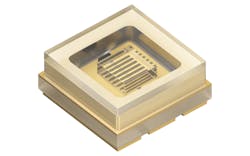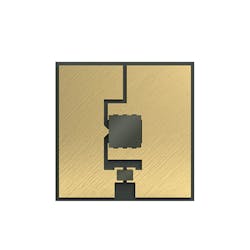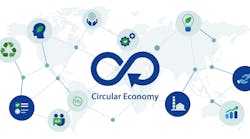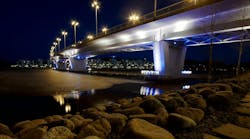A partnership between ams Osram and the University of Padua has revealed germicidal ultraviolet (GUV) research that charts the dose of UV-C radiation relative to exposure time to deactivate pathogens such as the coronavirus — an exercise that may prove especially valuable for applications such as upper-air disinfection systems. Crystal IS, meanwhile, has a new UV-C emitter called the Klaran LA that it says can deliver 100 mW with what the company calls (but doesn’t define) extended lifetimes. Nichia has also added a UV-C component in the NC4U334BR product that integrates multiple emitters for water disinfection systems.
UV-C research
We’ve covered research on UV-C technology repeatedly relative to deactivation of pathogens including the SARS-CoV-2 coronavirus. Early on in the COVID-19 pandemic, for instance, we covered Boston University work with Signify lamps that said UV-C radiation could approach 100% elimination of SARS-CoV-2. We later covered the germicidal performance of LEDs including Nichia components studied by Nagasaki University. But much of that work has shared a common trend in that the research sought to prove that a given dosage of UV-C energy could immediately deactivate pathogens such as SARS-CoV-2.
Editor's note: With regard to GUV usage, "dose" typically refers to the output power of the UV-C light engine or source. "Dosage" is the dose (output power, typically in milliwatts) over time (typically a metric of mJ/cm2) to deactivation of a pathogen.
The ams Osram and University of Padua work we will cover here is a bit different. The research team recognized that disinfection systems, especially some that can best leverage LEDs, might not operate instantaneously. For example, an upper-air disinfection system might realistically require multiple passes of air through the system to deactivate the virus. So the team established the dosage levels for immediate deactivation but also tested a broad range of lower radiation levels relative to the time to deactivation.
The team designed a custom system and mixing chamber, with reflective UV-C surfaces, that is based on low- and high-power Osram UV-C LEDs. The two different power classes within the Oslon UV 3636 portfolio radiated at 4 and 42 mW, respectively. All of the LEDs radiated at 275 mW and the system was located 300 mm from the pathogens.
Radiation at a dosage of 3.6 mJ/cm2 was shown to deactivate 99.99% of the pathogens instantaneously, or what is referred to as a log4 reduction. At the lower radiation dosage of 2.7 mJ/cm2 the system achieved a log3 or 99.9% reduction in pathogens. But what about much lower dosage levels?
As stated before, the test system could cover a broad output power or dosage range. So the researchers tested the system at power levels of 1100 W/m2, 0.085 W/m2, and 0.008 W/m2. The dosage would be determined by exposure time, and the team sought to create scenarios that delivered equivalent dosage. The highest-power setting was used for 13 sec to deliver a dosage of 1.43 mJ/cm2, the middle-power level required 180 sec to deliver a dosage of 1.52 mJ/cm2, and the lower-power level needed 1800 sec to yield dosage of 1.46 mJ/cm2. The three tests delivered -1.46log, -1.17log, and -1.61log reductions in pathogens respectively. Product developers will be able to learn from this methodology to apply the results in developing systems that generally aren’t intended to deactivate pathogens immediately but that operate continuously over time.
Crystal IS LED
Moving to new UV-C components, the Klaran LA LED is based on the company’s homogeneous strategy of growing aluminum nitride (AIN) epitaxial layers on AIN substrates, whereas most of the UV LED industry is using sapphire substrates as has most of the visible-light industry. Crystal is a subsidiary of Asahi Kasei and even pre-pandemic had delivered some components into applications such as water disinfection.
The newest components operate in the 260–270-nm range and Crystal IS said it has achieved the performance leveraging the unique materials architecture and realizing a lower forward voltage. “It’s a game-changing innovation in performance for our partners as they seek to integrate more effective, longer-lasting, and more cost-effective UV-C disinfection into their product lines and systems,” said Eoin Connolly, president of Crystal IS. “The Klaran LA offering of 100 mW, available in quantity at $0.10 per mW and in the ideal germicidal range of 260–270-nm, continues to demonstrate the power of Crystal IS’ proprietary aluminum nitride substrates — high yields of high output devices at deep UV wavelengths.”
Nichia at 280 nm
Moving to Nichia, that company continues to ply the waters at 280 nm, the very upper limit of the UV-C band. The company has maintained that even as dosage requirements go up at 280 nm, it can deliver higher-output devices with longer lifetime and lower cost at 280 nm. Back in September we covered the company’s latest 3535 LED that delivered 62 mW.
In October, Nichia went to a larger 6868 form factor and multiple emitters to deliver even more UV-C radiation. The company said that the NC4U334BR product can be used in industrial water and air disinfection systems. Nichia believes that the instant on and off capabilities of the LED will enable the components to start displacing lamps in disinfection systems.
LEDs Magazine chief editor MAURY WRIGHT is an electronics engineer turned technology journalist, who has focused specifically on the LED & Lighting industry for the past decade.
*Updated Nov. 9, 2021 10:24 AM for clarification of UV dose and dosage terms.
For up-to-the-minute LED and SSL updates, why not follow us on Twitter? You’ll find curated content and commentary, as well as information on industry events, webcasts, and surveys on our LinkedIn Company Page and our Facebook page.







